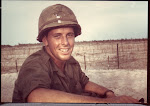DANANG: Le Ly Hayslip has taken on the French and
American armies as a child in Ky La a small farming village where she was born
outside of Da Nang in Central Viet Nam.
She made it in America after her husband died. She had moved there after marrying an American
contractor during the Viet Nam War.
She
conquered the publishing world with her best seller “When Heaven and Earth
changed Places” and she worked with Oliver Stone on the movie based on that
book, “Heaven and Earth”. She has
survived the bureaucratic intricacies of founding and operating in the NGO
(Non-governmental Organization) world in the United States and Viet Nam.
However with
the expansion and development going on today in Viet Nam, local land owners like
herself are in the position of being pushed aside for the so called ’larger
good’.
The ex GIs
from Plattsburgh, Corky Reinhart, Neil Tallon, Pete Conroy along with Mark
Conroy from Danang are accompanying Le Ly for a visit to her ancestral home. Ms. Hayslip has just recently returned from
the US where she was awarded the Ryan C Crocker Global Citizen of the Year award.
 |
| Adam Conroy, Mark Conroy, Neil Tallon, Hai Ngai & Le Ly Hayslip at the family home in Ky La village. |
“They’ve
already pushed a large highway through the rice fields in back of my village
and now they’re trying to take my front yard for a road expansion at our home
farm here,” says Le Ly to her
companions.
“Looks just
like the Northway when it pushed through our farm in Beekmantown,” says Pete
Conroy. “Looks just like they did to the
‘Creek’ during the early Urban Renewal on North Margaret Street in
Plattsburgh,” says Neil Tallon.
The trail
from Le Ly’s house leading to the rice fields out back has been a major
infiltration route in to the village for the opposition in both the French and
the American war. Both armies used her
family’s small house as an outpost for small detachments of troops during their
respective wars. It was rebuilt after
the French burned it when they left in 1954.
“Every morning when we got up we didn’t know
if we’d survive the day. Every night
when we went to bed we didn’t know if we’d wake up in the morning” said Le
Ly. “It was terrible. We were caught in the middle”.
All of these
village houses had their own bunker to hide in when troops came or there was
bombing in the area. They were defensive
in nature but could be construed as offensive by GIs whose main mission was to
stay alive.
 |
| Le Ly Hsyslip, Corky Reinhart & Pete Conroy on the path where American GIs shot a (VC) Viet Cong soldier when based in Le Ly.s family home. |
Le Ly Hayslip, Corky Reinhart & Pete Conroy on the path where American GIs shot a VC (Viet Cong) soldier when based in Le Ly’s family home.
“We weren’t
told anything about them officially”, said 1st Cav. Veteran Pete
Conroy. “Our previous knowledge was from
soldiers who were here earlier in the war and they said to be suspicious of
everything. It might be a spider hole
with a sniper waiting inside.”
This did not
bode well for the villagers. Le Ly
recalls getting on well with the soldiers during wash ups at the well and at
cookouts on campfires in the back yard. But when the soldiers went out back on patrol
and stepped on mines suffering severe casualties, the mood changed
rapidly. Medivacs flew out the dead and
wounded, but then gunships and fresh troops arrived with guns blazing. VC insurgents were killed, but so were many
innocent villagers.
“I can’t
imagine living here for all those years under those conditions”, mused Corky
Reinhart the retired professor who has taught Viet Nam War history at various colleges
and universities. “These poor people.”
Le Ly left
her village for Saigon, along with her mother in 1964 because both the US
troops and the VC wanted to shoot her.
She was 14 years old at the time.
Her older sister Hai Ngai who today is 92, has lived in this house
throughout both wars, and still does.
She suffers mental trauma to this day from the experiences of those
years.
*A version of this article appeared in the Press Republican on April 16, 2014.

No comments:
Post a Comment